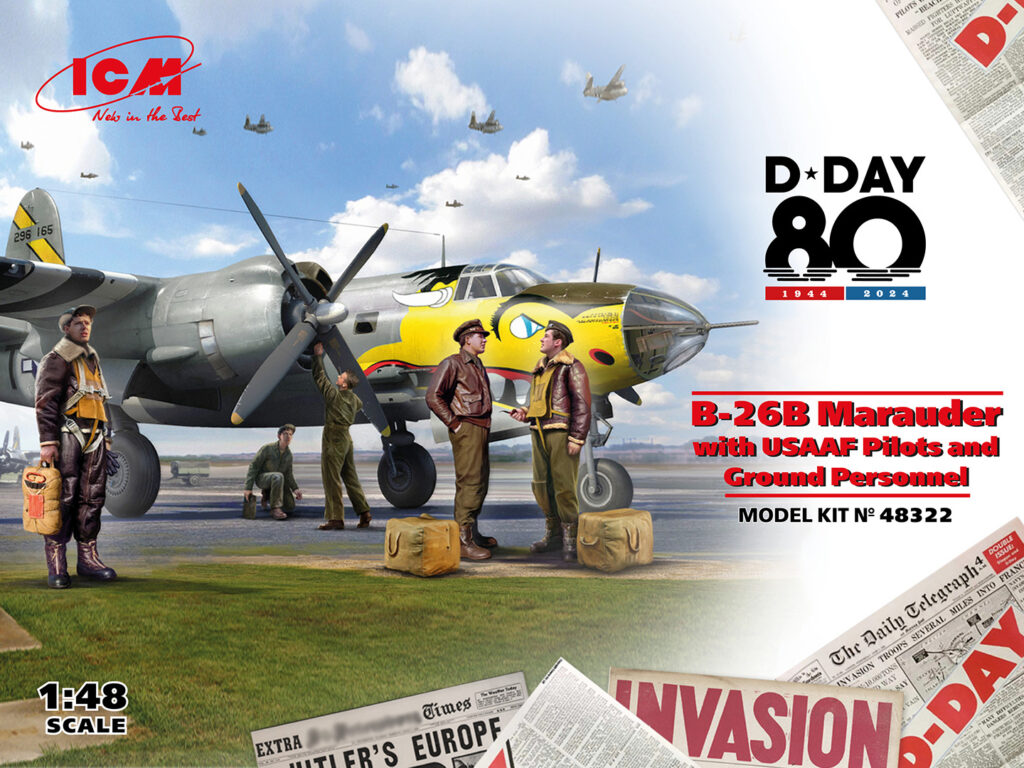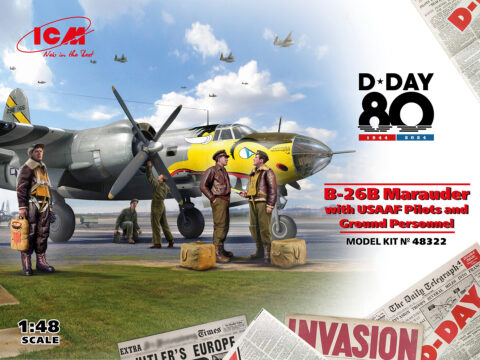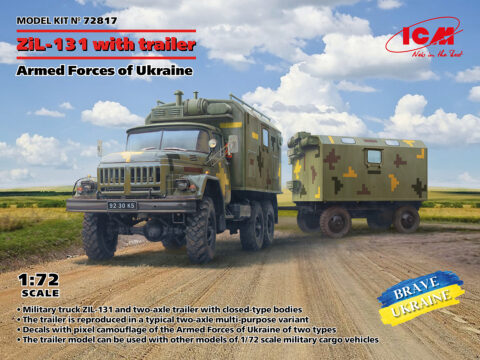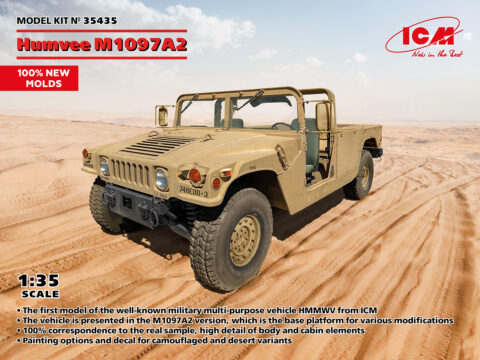Industry News
ICM News Jun 2024
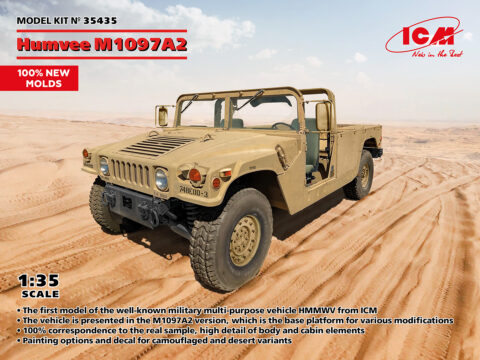
1/35 Humvee M1097A2
In 1979, the U.S. Army ordered the development of a new multi-purpose vehicle to replace several types of military transport vehicles. An interesting feature was the requirement for the vehicle to be able to move behind tanks on the tracks laid by their caterpillar tread. This resulted in a characteristic feature of the new vehicle’s appearance: it received a wide wheel track and high ground clearance. In 1985, after a series of tests, mass production of the new highly mobile multi-purpose wheeled vehicle, which received the designation HMMWV, began. In the U.S. Army, it was named Humvee, a name that later became widely known (it was an abbreviation of HMMWV). The vehicle serves as a base for many modifications with various purposes. It is widely used around the world and is in service with the armies of more than 70 countries. The M1097A2 modification is the basic platform of the next generation of these vehicles and is used for transporting personnel and cargo, as well as for mounting various types of special equipment and weapons.
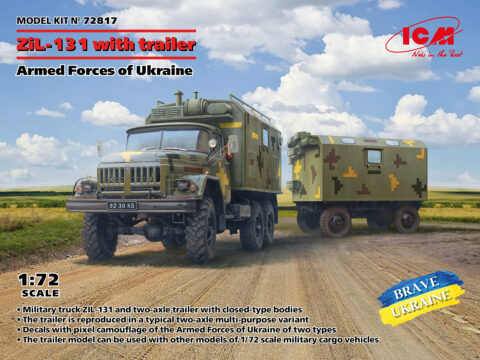
1/72 ZiL-131
Truck with trailer Armed Forces of Ukraine
The Armed Forces of Ukraine operate a large number of various types of trucks. These are used for transporting personnel, ammunition, military cargo, and towing artillery guns. A certain part of the vehicle fleet consists of modern models of Ukrainian and Western production. At the same time, the Armed Forces of Ukraine also use a significant number of various trucks left after the collapse of the USSR. One such model is the all-wheel-drive ZiL-131. Its production began in the late 1960s, and in 1986, an upgraded version, the ZiL-131N, was introduced. The truck is distinguished by its high reliability and good off-road capability. Some of the vehicles were equipped with van bodies, also known as KUNG (standardized body of zero (normal) dimensions). In addition to trucks, various trailers with van bodies are actively used, designed for accommodating personnel, laboratories, repair workshops, field kitchens, electronic systems, or medical units. They can be equipped with lighting systems, power supply systems, and heating devices.

1/48 B-26B Marauder with USAAF Pilots and Ground Personnel
The first prototype of the B-26 bomber got off the ground on November 25, 1940, and it was adopted by the U.S. Air Force in February 1941. During its servicing, the design of the bomber was constantly changed to improve its flight and combat characteristics. The latest modification, the B-26B Marauder (B-26B-55-MA), was produced until February 1944. These aircraft actively participated in U.S. operations in Europe, initially based in Britain, and from the second half of 1944, on the mainland of Europe. The air raids inflicted significant damage on the enemy’s economy and required considerable effort from their air defense forces. B-26B Marauder bombers also played an active role in the preparation and execution of the strategic airborne operation “Overlord” – the Allied landing in Normandy. On D-Day, June 6, 1944, bombers of the 9th U.S. Air Force (including the B-26B Marauder) were airborne. The aircraft bombed coastal batteries, bridges, railway junctions, and other targets. The massive raids continued for several days after the invasion, with up to four hundred Marauders participating simultaneously.

1/35 ‘Sankas’
WWII Wehrmacht Ambulance Trucks
All tasks related to the medical support needs of the Wehrmacht were carried out by the Army Medical Service (Sanitaetskorps der Armee in German). Various transport vehicles were used for the transportation of the wounded, including horse-drawn carts, armored personnel carriers, or ambulance trucks. Ambulance trucks for evacuating the wounded were mostly converted versions of military and civilian vehicles, including both standard wheeled vehicles and half-tracked “Maultiers.” These vehicles had enclosed bodies equipped with stretchers for transporting the wounded. They also had markings and camouflage corresponding to the military unit to which the vehicle belonged. The Red Cross was painted in a white circle or square without a strictly defined size. Often, the only marking on the trucks was a white flag with a red cross. In Wehrmacht soldier folklore, medical transport vehicles were nicknamed ‘Sanka.’
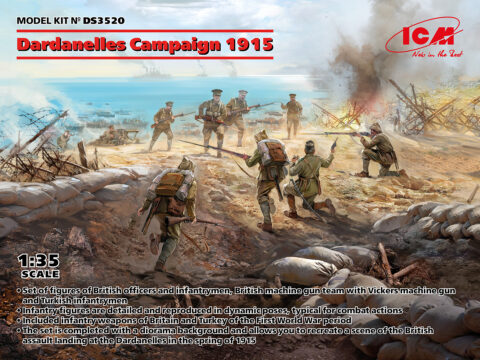
1/35 Dardanelles Campaign 1915
At the beginning of 1915, the Allied command of the Entente decided to conduct a naval operation in the Dardanelles Strait. The author of the plan was the First Lord of the Admiralty, Winston Churchill, and the goal was to capture the Dardanelles and break through to Istanbul. According to the initial plan, this goal was to be achieved solely through the use of warships. These vessels were expected to destroy the fortifications and coastal batteries, which would compel the Turkish ground forces to retreat inland. However, everything did not go according to plan, and in April 1915, the Allies were forced to start a landing operation. At the cost of significant losses, they managed to capture a small piece of land in the strait, but the strong resistance from the Turkish army did not allow them to develop further success. By the end of August 1915, it became clear that the operation had failed, and a decision was made to evacuate the Allied ground units. The last military units were evacuated in the winter of 1916. The British Empire’s losses in this campaign amounted to 113,000 soldiers, while the Turkish army lost about 250,000 soldiers.
HobbyLink International
eBay Store

